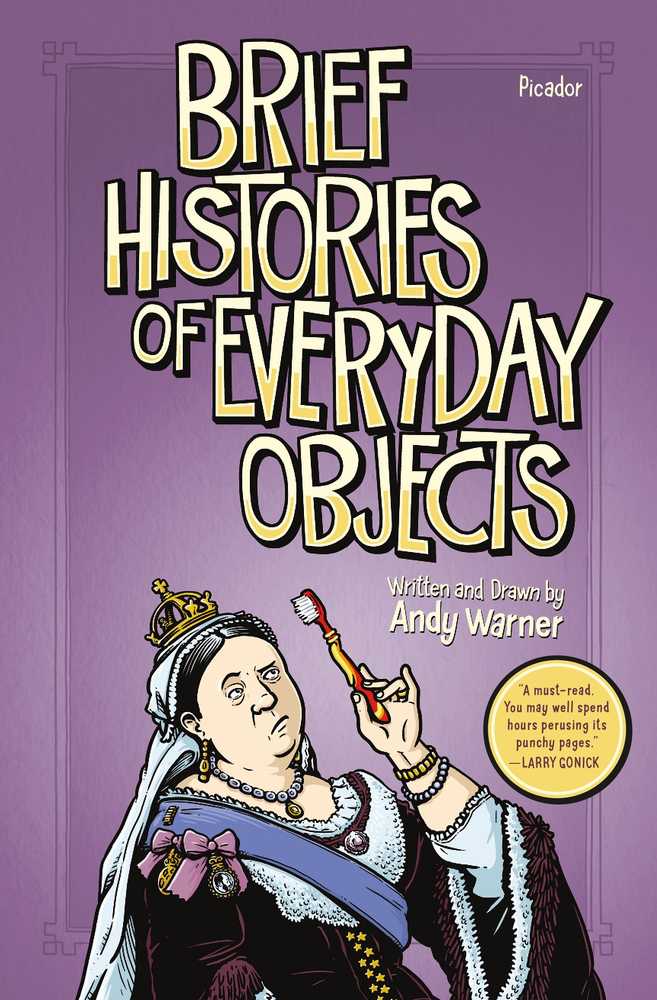Imagine the first person who created a toothbrush.
Better yet – imagine life before a toothbrush. Think about it: getting your mouth minty-fresh wasn’t exactly easy with twigs or rags. Same things with clean hair, unspoiled leftovers, unsmelly bathrooms, or cool gamepieces, as you’ll see in “Brief Histories of Everyday Objects” by Andy Warner.
Scientists say you do your best thinking in the shower.
That’s where Andy Warner was on the morning he was trying to “come up with an idea for a comic.” Sadly, there wasn’t much story in a showerhead, but his toothbrush turned out to be a pretty interesting thing. It also opened the door to more.
Take, for instance, shampoo.
Yes, people washed their hair prior to the 1860s but Sarah Breedlove saw a special need for special hair formula. Prior to Breedlove’s hair-care products, African American women used goose fat to tame their locks. Breedlove’s concoction, it should go without saying, was a whole lot better product.
Or how about shaving: King Gillette (his real first name, not a British title) made a fortune, but not from razors. He sold those at a loss but got rich from the disposable blades that went inside those razors. Genius marketing, no?
The toilet you used this morning got its start in the 12th century in Baghdad. Kitty litter began as place for hens to lay their eggs. The guy who invented the modern safety pin sold the idea for a lousy $400. Six-sided dice are ancient things, at least 5,000 years old; dominoes, as Warner points out, are basically flat dice. A German woman invented coffee filters, but she had a string of bad luck for the rest of her life: because of war and more war, she lost her factory twice. The man who invented traffic lights was the son of former slaves. When they were new, ballpoint pens were considered to be a luxury and sold for more than $12 each. Some fourteen million trees become paper bags each year in the U.S. And paper clips? They were once a “show… of defiance” against the Nazis.
The election is over. The semester’s almost finished. Even the year is running out of time. At the end of these (and your day), you want something light to relax with and “Brief Histories of Everyday Objects” is perfect.
Who doesn’t like to read comics? Yep, that’s how author-artist Andy Warner presents what you’ll learn here: quick chapters of illustrated info, offered in small bites of truth and funny bits of created dialogue. We get a good understanding of each main subject, and a few follow-up factlets to sweeten the enjoyment of a book like this.
Be aware that, while Warner admits in his introduction that “Brief Histories of Everyday Objects” is “as true as [he] could get it,” some dubious factoids might make you say, “Hmmm.” Happily, there’s a bibliography included, so go ahead and look things up. That’s part of the appeal of this book. Fun like that can’t be brushed away.
And if you love classical music, you’ll want to read the history of that, too, won’t you? Good thing “Beethoven’s Skull” by Tim Rayborn is out this fall.
In this book, you’ll read about composers and their works, music and those who made it, and the scandalous, scary, and strange things you never learned from music lessons. Set in different eras of composition, it’s also easy to find entries on your favorite composers or to learn about new ones. If you think classical music is boring and stuffy, this short-chaptered, informative book will make you change your tune.
The Bookworm is Terri Schlichenmeyer. Email her at bookwormsez@gmail.com.

